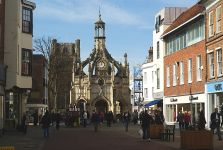Chichester (/ˈtʃɪtʃɪstə/ (listen)) is a cathedral city and civil parish in West Sussex, England. It is the only city in West Sussex and its county town. It was a Roman and Anglo-Saxon settlement and a major market town from those times through Norman and medieval times to the present day. It is the seat of the Church of England Diocese of Chichester, with a 12th-century cathedral.
The River Lavant, a winterbourne, runs through the city, mostly through culverts.
History
Roman period
There is no recorded evidence that the city that became Chichester was a settlement of any size before the coming of the Romans. The area around Chichester is believed to have played significant part during the Roman invasion of AD 43, as confirmed by evidence of military storage structures in the area of the nearby Fishbourne Roman Palace. The city centre stands on the foundations of the Romano-British city of Noviomagus Reginorum, capital of the Civitas Reginorum. The Roman road of Stane Street, connecting the city with London, started at the east gate, while the Chichester to Silchester road started from the north gate. The plan of the city is inherited from the Romans: the North, South, East and West shopping streets radiate from the central market cross dating from medieval times.
The original Roman city wall was over 6+1⁄2 feet (2.0 m) thick with a steep ditch (which was later used to divert the River Lavant). It survived for over one and a half thousand years but was then replaced by a thinner Georgian wall.
The city was also home to some Roman baths, found down Tower Street when preparation for a new car park was underway. A museum, The Novium, preserving the baths was opened on 8 July 2012.
An amphitheatre was built outside the city walls, close to the East Gate, in around 80 AD. The area is now a park, but the site of the amphitheatre is discernible as a gentle bank approximately oval in shape;
